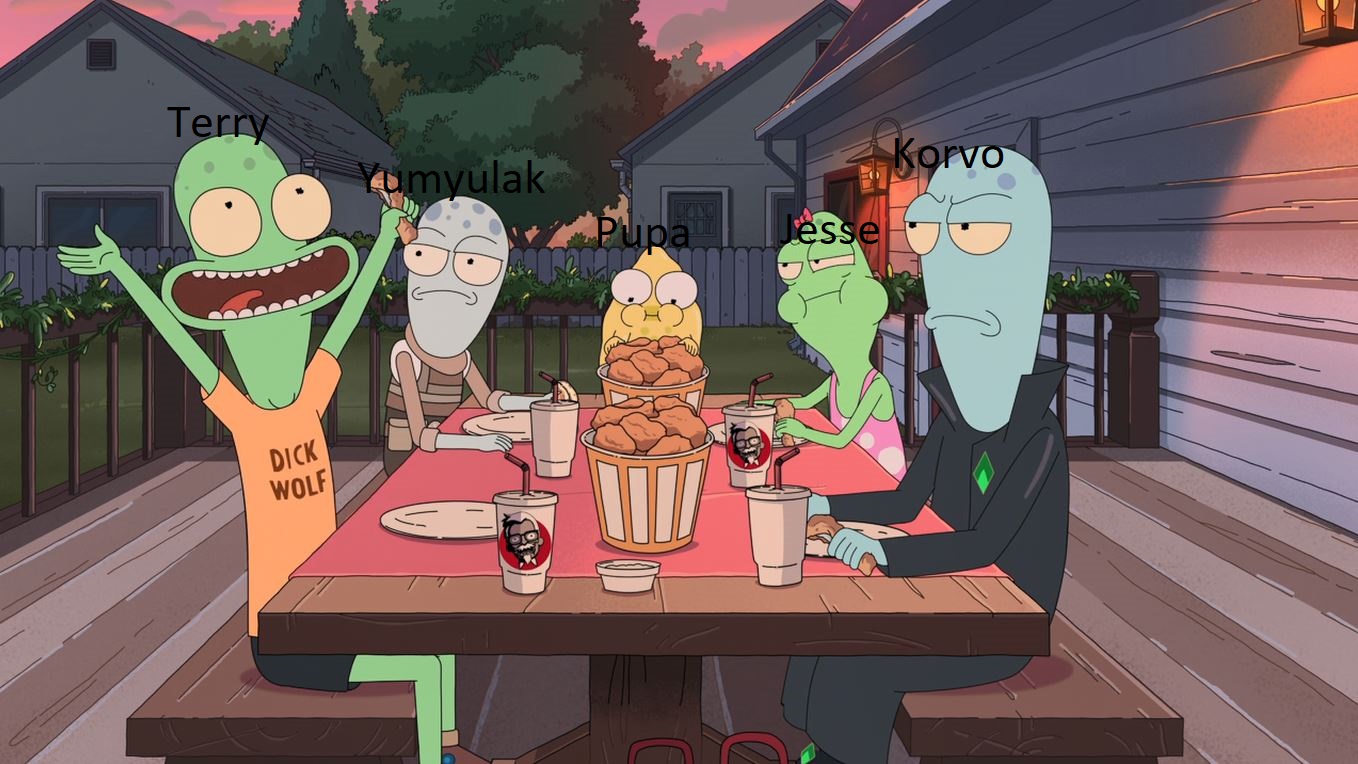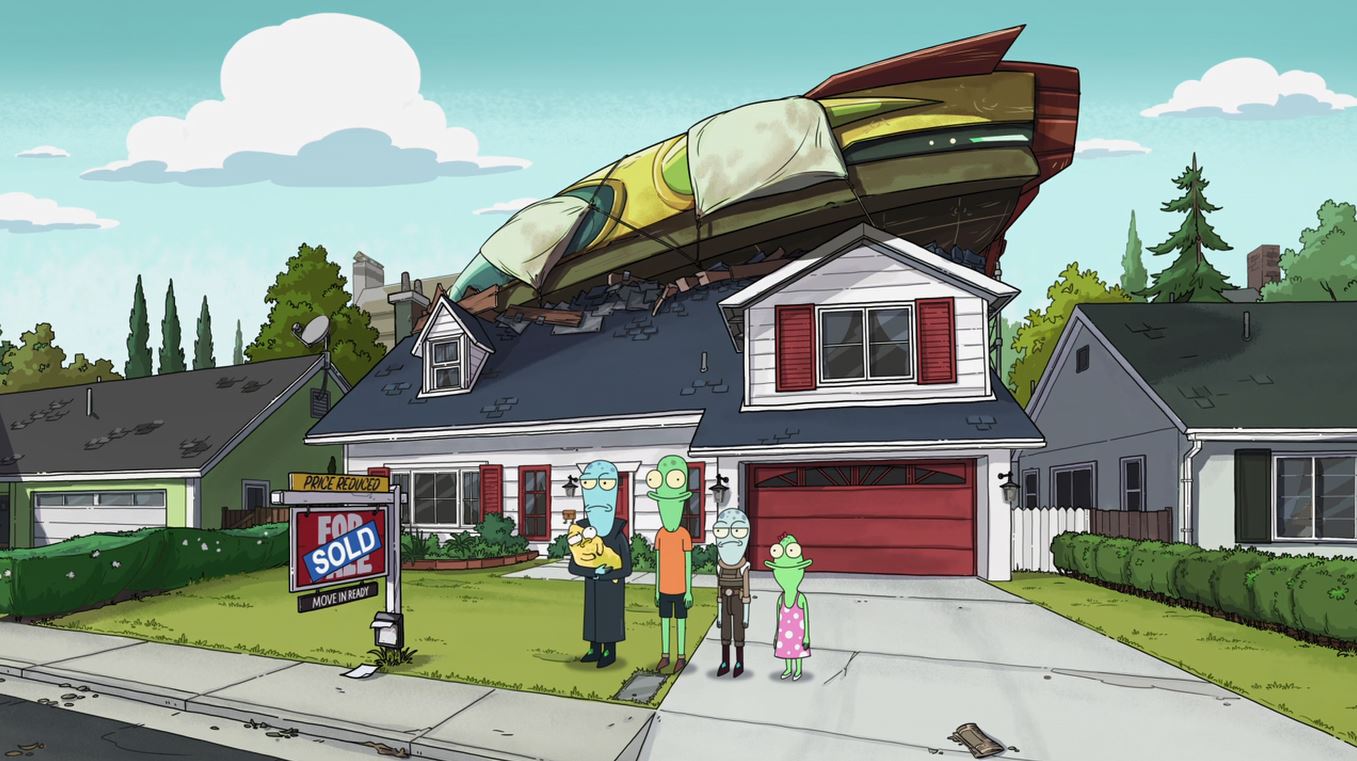‘Solar Opposites’ is a Hulu adult animated series by Justin Roiland, one of the creators of ‘Rick and Morty.’ The show promises to present another mind-bending and smartly slapstick animated production of queer quality.
For a long time, adult animated comedy has been an overcrowded genre but one with a handful of clear “toppers” that can boast of nailing the perfect balance between zaniness and wit. ‘Solar Opposites’ arrives with the promise of being another headliner, but one which can challenge the now-stale dominance of Seth MacFarlane shows. To be clearer, ‘Solar Opposites’ can be characterized as an animated “family” sitcom. Roiland voices one the “parents,” Korvo, similar to how he voices both the titular characters on ‘Rick and Morty.’
Solar Opposites Recap:
‘Solar Opposites’ revolves around an alien family that is forced to move to Earth after their planet, Shlorp gets hit by an asteroid. The Shlorpian family consists of Korvo, Terry, Yumyulack, Jesse, and a “Pupa.” Korvo and Terry can be considered to be the same-sex “parents,” but as far as the first season goes, they do not seem to share a romantic connection (they definitely see other people sexually, sometimes with the other person in the same bed, indicating an open relationship at best). They are partners who were assigned to be with each other once Shlorp would destroy. Korvo is the evacuation partner. Terry is the Pupa specialist. Yumyulack and Jesse are Terry and Korvo’s “replicants.”

Each “family” was assigned a “Pupa:” an adorable, Shlorpian, infantile organism who would eventually grow large in size and destroy the planet that it was taken to it. In this manner, Shlorpians would be able to inhabit multiple planets since 100 hundred adults, and their replicants were assigned a Pupa of their own, tasked with finding a new home. These Shlorpians crashed on Earth.
Each episode of the series sees the Shlorpians get into various, mostly self-sustaining misadventures as they acclimatize to living on Earth. Terry is the one who has adapted to the new planet the most and is always (sometimes irritably) positive. Korvo is equally cynical, attempting to fix their spaceship so that they can leave this “overpopulated planet.”
Jesse and Yumyulack try to fit in at their new school unsuccessfully. They use a shrink ray to contract any human that irritates them. Yumyulack seems to shrink people for the tiniest of flaws, at first. The replicants put the shrunk humans in a cupboard-like object on their wall. Throughout the season, the tiny humans start to live as if they were in a post-apocalyptic society, which they call “The Wall.” A power struggle between an authoritarian figure, The Duke, and Tim, who organizes a resistance movement ensues.
Solar Opposites Review:
To begin with, ‘Solar Opposites’ will prove to be familiar to adult animated fans as there are elements from multiple shows. There are enough of these familiar elements for ‘Solar Opposites’ to feel borrowed, but there is ample originality in its overall, composite premise to delight viewers. Firstly, the heady and quick-paced tone of each episode would be something that is distinctly ‘Rick and Morty.’ It is created by Justin Roiland after all. However, ‘Solar Opposites’ is less anthological, trippy, and mindbending but more stable and continual.
Moving on, the family sitcom-like style is reminiscent of MacFarlane’s shows. Its alien characters would instantly remind one of ‘American Dad!,’ the difference being that MacFarlane’s show just has one extra-terrestrial character. Moreover, ‘Solar Opposites’ is way more science-y, with increased reliance on smart, reflective humor rather than fart jokes. Hence, the Hulu animated series easily manages to cast its own voice in an overcrowded adult animated world.
‘Solar Opposites’ employs a very healthy laughs-per-minute number: something which is, once again, similar to the style of ‘Rick and Morty’ and MacFarlane (at his best). There is never a dearth of humor. But at the same time, the story moves at a lightning pace. However, one thing that ‘Solar Opposites’ does differently is the way each of its self-sustaining sitcom-style plots in every episode has an impact on the next one, and the series in general. This impact is more than just running gags. Hence, unlike, say, ‘The Simpsons,’ time does move forward. There is an effect to every cause.
‘Solar Opposites’ is not flawless, however. When it comes to societal reflection, there are moments where it does not hit the ray on target at all times. For instance, there is an episode that revolves around gender, but it does not prove to be as insightful as some of the other moments on the show. At best, that episode, which sees Terry and Korvo make a female housewife robot, feels oversimplified and outright ignorant of real issues. But hey, the Shlorpians are aliens and cannot be judged by human standards (their words, not mine).
However, that is just one of the tiny blemishes in a series that is otherwise thoroughly entertaining. Another one would be the series’ cliched format. Although, as mentioned earlier, Roiland and Mike McMahan (co-creator) sprinkle enough originality to present a unique twist, the animated family sitcom format does start to feel slightly dated. But that is definitely not the fault of the creators, and if the first season is anything to go by, one may expect more pivots and nudges to the now-commonplace style.
Read More: Best Adult Animated Series on Netflix


You must be logged in to post a comment.